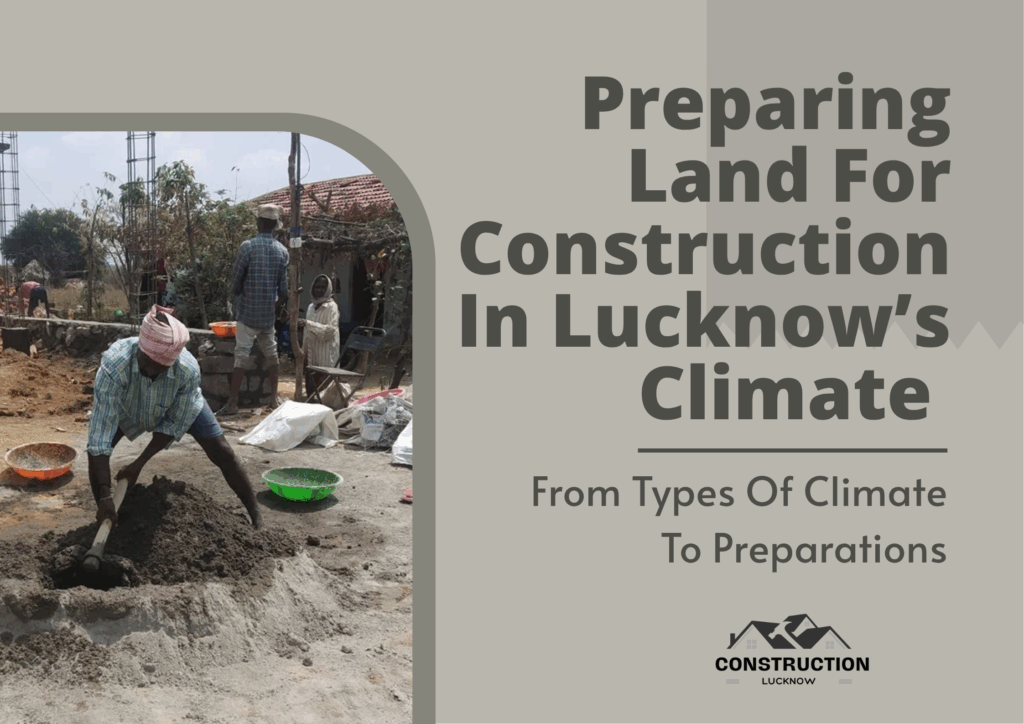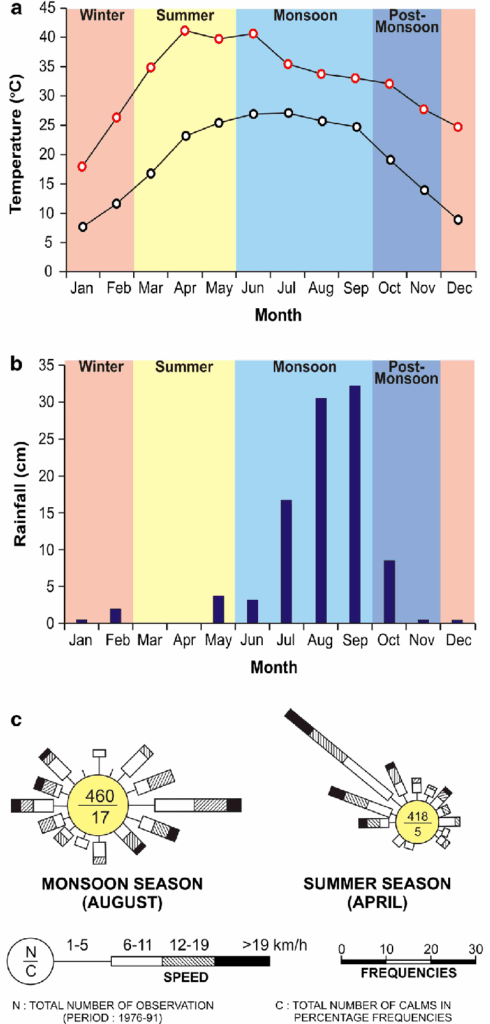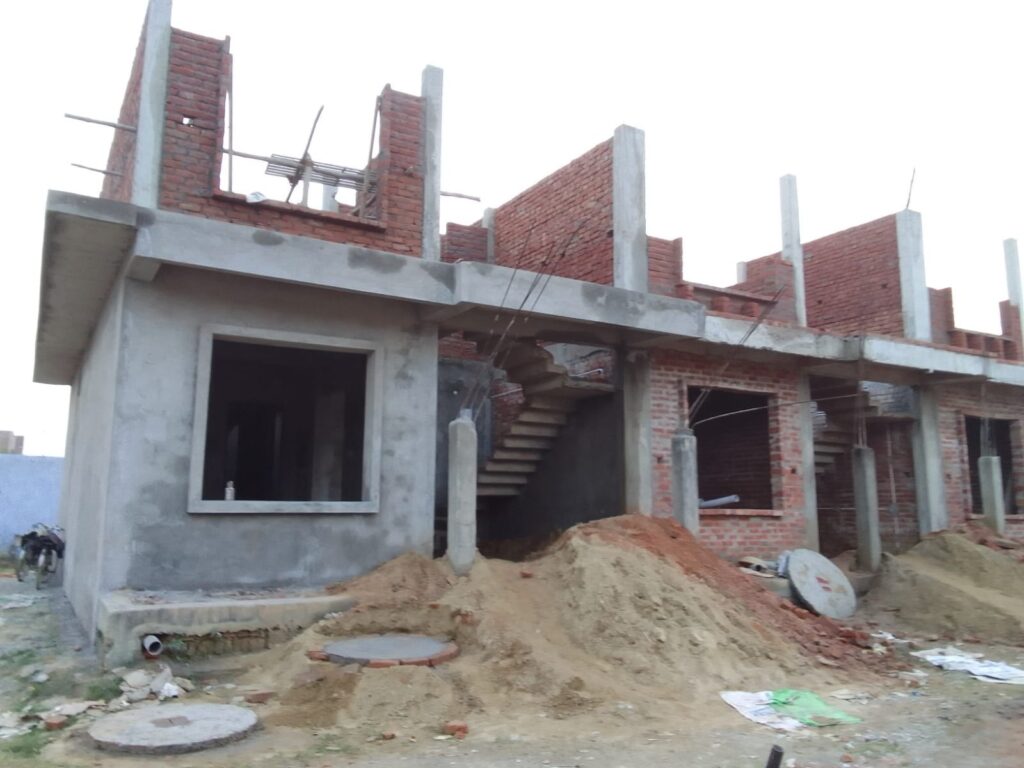Building a house is a big dream for every family. But before you start putting bricks together, you need to get your land ready first. In Lucknow, the weather changes a lot during the year, and each season brings its own challenges for construction work. Preparing land for construction in Lucknow’s climate (type of climate — and preparations) is not a joke. Let’s get into it.

Lucknow’s Weather Pattern
Lucknow has what we call a subtropical climate (उपोष्णकटिबंधीय जलवायु). This means we get very hot summers, heavy rains during monsoon, and cool winters. The city sits in the Gangetic plains, so the land here is mostly flat with clay and sandy soil mixed together.
The year has four main seasons:
- Summer (March to June) – Very hot and dry
- Monsoon (July to September) – Heavy rains and flooding
- Post-monsoon (October to November) – Pleasant weather
- Winter (December to February) – Cold and foggy
Getting Ready for Monsoon Season
Monsoon is coming soon, and this is the most important time to prepare your land. The rains in Lucknow can be very heavy, sometimes 100-150mm in just one day. Areas like Gomti Nagar, Alambagh, and Charbagh often see waterlogging (जल भराव) during heavy rains.
What You Must Do Before Monsoon:
Check Your Land’s Height: Walk around your plot and see if water collects anywhere. Low spots will become ponds during rains. Fill these areas with good soil mixed with sand. The land should slope slightly so water flows away from where you plan to build.
Dig Drainage Channels: Make small channels (नालियां) around your land to carry rainwater away. These should be about 1 foot deep and 1 foot wide. Make sure they connect to the main road drain or a natural water flow.
Test Your Soil: Take soil samples from different corners of your land. Mix some soil with water in a glass. Good building soil will settle in layers – sand at bottom, clay in middle, and organic matter on top. If you see too much clay, you’ll need to add sand.

Build Temporary Fencing: Put up basic fencing around your land to stop mud and water from neighboring areas flowing onto your plot. Bamboo poles with plastic sheets work well and don’t cost much.
Store Building Materials Safely: If you already have bricks, cement, or sand on your land, cover them with plastic sheets. Raise them on wooden platforms so they don’t get wet from ground water.
Preparing for Other Seasons
Summer Preparation (March-June)
Summer in Lucknow is very harsh. Temperatures go up to 45-48 degrees. The soil becomes very hard and cracks appear everywhere.
What to do:
- Water your land lightly every few days to stop deep cracks from forming
- Cover any stored materials with cloth or tarpaulin (तिरपाल) to protect from heat
- Plan your digging and foundation work for early morning or evening hours
- Keep water barrels on site for workers and for dampening the soil
Post-Monsoon Time (October-November)
This is the best time for construction in Lucknow. The weather is pleasant, and the soil has good moisture content.
What to do:
- Start your main construction work now
- Check if monsoon caused any damage to your land preparation
- Level the land properly as the soil is soft and easy to work with
- Begin foundation digging as the ground conditions are perfect
Winter Preparation (December-February)
Winters in Lucknow bring fog and cold winds. Morning fog can be so thick that work stops for hours. Areas near River Gomti see more fog.
What to do:
- Plan work to start late morning when fog clears
- Protect fresh concrete from cold using gunny bags (बोरी)
- Keep construction materials dry as morning dew makes everything wet
- Use warm water for mixing cement on very cold days
Special Care for Different Areas in Lucknow
Old City Areas (Chowk, Aminabad): These areas have narrow lanes and old drainage systems. Extra care needed for water flow planning.
New Developments (Gomti Nagar, Indira Nagar): Better drainage, but the soil may have construction debris mixed in. Clean soil testing important.
Rural Areas (Malihabad, Kakori): Natural drainage better but may need to deal with agricultural runoff during monsoon.
Detailed Preparation Steps
Soil Testing and Improvement
Get your soil tested at the local agriculture office or engineering college. They charge very little money. Good building soil should have:
- 60-70% sand
- 20-30% clay
- Less than 10% organic matter
If your soil has too much clay, mix in river sand. If too much sand, add some clay. Never use soil with lots of organic matter for foundation.

Water Management System
Create a proper water management plan:
- Mark the highest and lowest points on your land
- Plan water flow from high to low areas
- Connect to street drainage or make a soakage pit (सोखने का गड्ढा)
- Keep drainage channels clean and free from garbage
Foundation Planning
Plan your foundation based on soil type:
- For clay-heavy soil: Go deeper (at least 4-5 feet) and use more concrete
- For sandy soil: Normal depth (3-4 feet) but wider foundation base
- For mixed soil: Test load-bearing capacity first
Climate and Construction Preparation Guide for Lucknow
Season-wise Preparation Table
| Season | Time Period | Weather Conditions | Main Challenges | Land Preparation Tasks | Materials Care |
| Summer | March-June | Very hot (up to 48°C), dry winds, soil cracking | Heat stress, water shortage, hard soil | • Water land weekly to prevent deep cracks • Plan work for early morning/evening • Prepare shade for workers | • Cover with cloth/tarpaulin • Keep cement bags in shade • Store water for mixing |
| Monsoon | July-September | Heavy rainfall (100-150mm/day), flooding, high humidity | Waterlogging, soil erosion, material damage | • Build drainage channels • Fill low-lying areas • Create water flow slopes • Put temporary fencing | • Cover all materials with plastic • Raise storage on platforms • Check covers daily |
| Post-Monsoon | October-November | Pleasant weather, good humidity, soft soil | Minor – best construction time | • Level the land properly • Start foundation digging • Check monsoon damage • Begin main construction | • Normal storage • Best time to bring new materials • Check quality after monsoon |
| Winter | December-February | Cold (5-10°C), thick fog, morning dew | Poor visibility, cold concrete setting, wet materials | • Plan late morning start • Protect fresh work from cold • Keep drainage clear • Prepare for fog delays | Poor visibility, cold concrete setting, and wet materials |
Area-Specific Considerations in Lucknow
| Area Type | Examples | Special Challenges | Extra Preparations Needed |
| Old City | Chowk, Aminabad, Hussainabad | Narrow lanes, old drainage, water logging | • Coordinate with neighbors for drainage • Plan material delivery carefully • Check old sewer connections |
| New Developments | Gomti Nagar, Indira Nagar, Aliganj | Construction debris in soil, new infrastructure | • Extra soil cleaning required • Test for construction waste • Coordinate with ongoing developments |
| River Areas | Near Gomti River | High water table, flooding risk, soft soil | • Deeper foundation needed • Better drainage essential • Check flood history |
| Rural Areas | Malihabad, Kakori, Mohanlalganj | Agricultural runoff, seasonal flooding | • Plan for agricultural water flow • Account for seasonal water table changes • Coordinate with farming activities |
Monthly Weather Data for Planning
| Month | Temperature Range | Rainfall (mm) | Humidity % | Best Construction Activities |
| January | 5-20°C | 15-25 | 60-70 | Foundation work, brickwork |
| February | 8-25°C | 10-20 | 50-60 | All construction activities |
| March | 15-32°C | 5-15 | 40-50 | Heavy construction work |
| April | 22-38°C | 5-10 | 30-40 | Early morning/evening work |
| May | 26-42°C | 10-20 | 35-45 | Minimal outdoor work |
| June | 28-45°C | 30-50 | 45-55 | Land preparation only |
| July | 26-35°C | 200-300 | 80-90 | No construction – monsoon prep |
| August | 25-33°C | 250-350 | 85-95 | No construction – maintain site |
| September | 24-32°C | 150-200 | 75-85 | Site cleanup, damage assessment |
| October | 18-30°C | 20-40 | 60-70 | Resume construction |
| November | 12-26°C | 5-15 | 55-65 | Best construction time |
| December | 6-22°C | 10-20 | 65-75 | Foundation and basic work |
Common Mistakes to Avoid
Not Planning for Water Flow: Many people think their land is fine because it looks flat. But even a small slope can cause big water problems during monsoon.
Ignoring Soil Testing: Using any soil for the foundation is a big mistake. Clay soil expands and contracts, sandy soil may not hold weight properly.
Poor Timing: Starting construction work during monsoon or peak summer leads to poor quality work and higher costs.
Inadequate Drainage: Thinking that street drainage is enough. Your land needs its own water management system.
Cost-Saving Tips
- Use local materials like brick chips and sand from nearby areas
- Plan work during post-monsoon season when labor costs are normal
- Group work with neighbors to share machinery costs for land leveling
- Buy materials during summer when prices are lower, store them properly
When to Call Professionals
You can call us if:
- Your land has more than 3 feet of height difference across the plot
- Water stays on your land for more than 24 hours after rain
- You see signs of underground water springs
- Neighboring constructions have foundation problems

Frequently Asked Questions
When is the best time to start land preparation in Lucknow?
The best time is October to November, right after the monsoon. The soil is soft, the weather is pleasant, and you have enough time to complete the preparation before the next monsoon season.
Can I start construction during monsoon in Lucknow?
No, never start construction during monsoon (July-September). Heavy rains make it impossible to work, damage materials, and create poor quality foundation. Use this time for planning and material preparation only.
How much does land preparation cost in Lucknow?
For a typical 1000 sq ft plot, basic land preparation costs between ₹15,000 to ₹25,000. This includes soil testing, leveling, and basic drainage. Costs vary based on how much work your land needs.
My land gets flooded every monsoon. What should I do?
You need to: 1) Raise your land level by adding good soil, 2) Create proper drainage channels around the boundary, 3) Install a water pump if the area is very low-lying, 4) Coordinate with neighbors for a community drainage solution.
How deep should the foundation be in Lucknow soil?
For normal single-story houses, the foundation should be 4-5 feet deep in clay soil and 3-4 feet deep in sandy soil. For two-story buildings, go 6-7 feet deep. Always consult a local engineer for your specific soil type.
Final Words
Getting your land ready for construction is not just about making it look flat and clean. In Lucknow’s changing weather, proper preparation saves you money, time, and future headaches. The key is understanding how each season affects your land and planning accordingly.
Remember, monsoon is coming soon. Use this time to get your land ready. Good preparation now means smooth construction later and a strong house that will last for generations.
Start early, plan properly, and don’t try to save money on important things like soil testing and drainage. Your house is probably the biggest investment of your life – make sure it starts with a strong foundation on well-prepared land.
If you need help, talk to us, or learn from neighbors who have built successfully. Every plot of land in Lucknow has its own personality – get to know yours before you start building your dream home.
